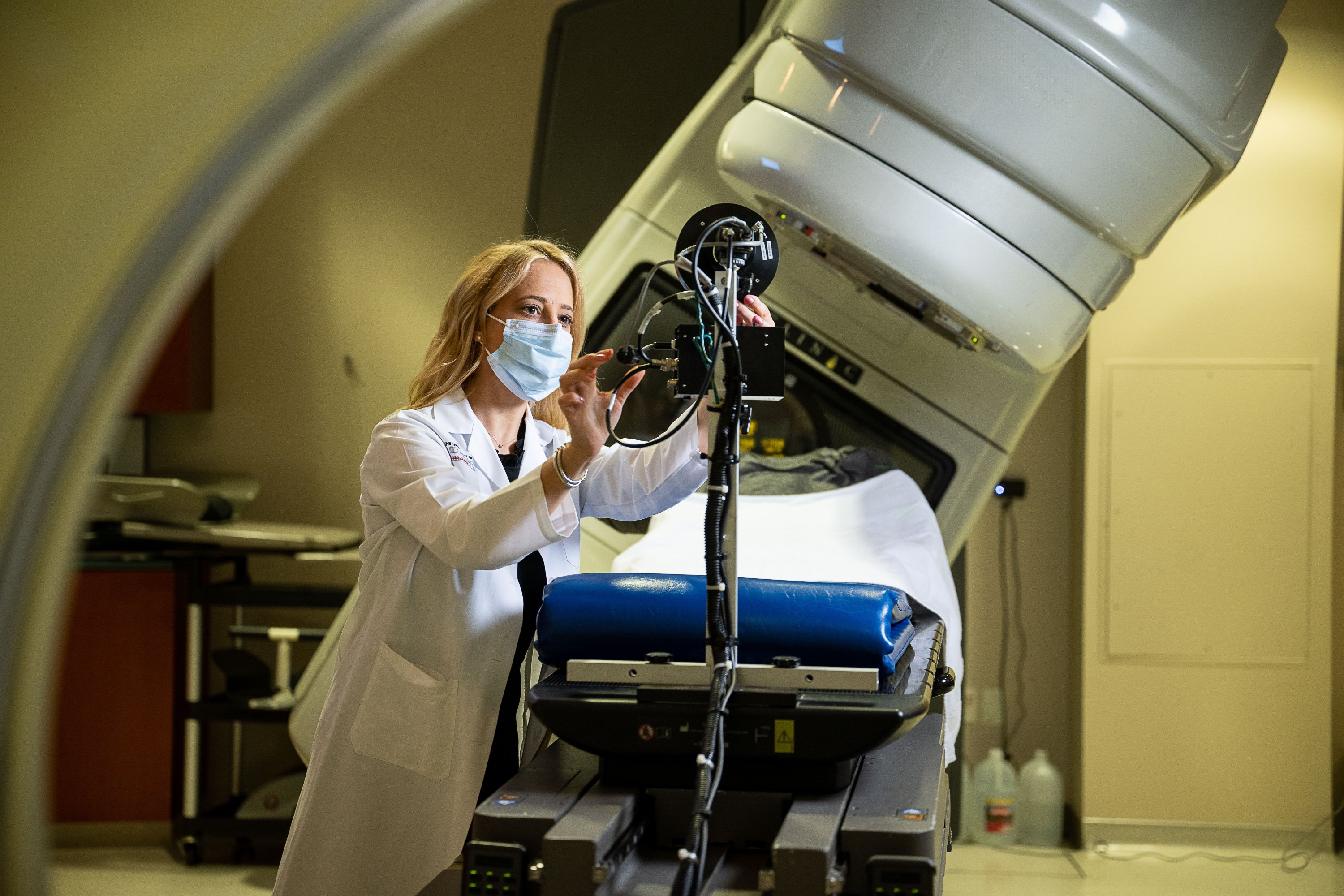- Diseases
- Acoustic Neuroma (14)
- Adrenal Gland Tumor (24)
- Anal Cancer (68)
- Anemia (2)
- Appendix Cancer (16)
- Bile Duct Cancer (26)
- Bladder Cancer (72)
- Brain Metastases (28)
- Brain Tumor (232)
- Breast Cancer (714)
- Breast Implant-Associated Anaplastic Large Cell Lymphoma (2)
- Cancer of Unknown Primary (4)
- Carcinoid Tumor (8)
- Cervical Cancer (158)
- Colon Cancer (166)
- Colorectal Cancer (118)
- Endocrine Tumor (4)
- Esophageal Cancer (44)
- Eye Cancer (36)
- Fallopian Tube Cancer (8)
- Germ Cell Tumor (4)
- Gestational Trophoblastic Disease (2)
- Head and Neck Cancer (12)
- Kidney Cancer (128)
- Leukemia (342)
- Liver Cancer (50)
- Lung Cancer (286)
- Lymphoma (278)
- Mesothelioma (14)
- Metastasis (30)
- Multiple Myeloma (100)
- Myelodysplastic Syndrome (60)
- Myeloproliferative Neoplasm (6)
- Neuroendocrine Tumors (16)
- Oral Cancer (100)
- Ovarian Cancer (172)
- Pancreatic Cancer (160)
- Parathyroid Disease (2)
- Penile Cancer (14)
- Pituitary Tumor (6)
- Prostate Cancer (146)
- Rectal Cancer (58)
- Renal Medullary Carcinoma (6)
- Salivary Gland Cancer (14)
- Sarcoma (238)
- Skin Cancer (296)
- Skull Base Tumors (56)
- Spinal Tumor (12)
- Stomach Cancer (64)
- Testicular Cancer (28)
- Throat Cancer (92)
- Thymoma (6)
- Thyroid Cancer (98)
- Tonsil Cancer (30)
- Uterine Cancer (80)
- Vaginal Cancer (16)
- Vulvar Cancer (20)
- Cancer Topic
- Adolescent and Young Adult Cancer Issues (20)
- Advance Care Planning (10)
- Biostatistics (2)
- Blood Donation (18)
- Bone Health (8)
- COVID-19 (362)
- Cancer Recurrence (120)
- Childhood Cancer Issues (120)
- Clinical Trials (632)
- Complementary Integrative Medicine (22)
- Cytogenetics (2)
- DNA Methylation (4)
- Diagnosis (232)
- Epigenetics (6)
- Fertility (62)
- Follow-up Guidelines (2)
- Health Disparities (14)
- Hereditary Cancer Syndromes (126)
- Immunology (18)
- Li-Fraumeni Syndrome (8)
- Mental Health (116)
- Molecular Diagnostics (8)
- Pain Management (62)
- Palliative Care (8)
- Pathology (10)
- Physical Therapy (18)
- Pregnancy (18)
- Prevention (918)
- Research (392)
- Second Opinion (74)
- Sexuality (16)
- Side Effects (604)
- Sleep Disorders (10)
- Stem Cell Transplantation Cellular Therapy (216)
- Support (402)
- Survivorship (322)
- Symptoms (182)
- Treatment (1786)
Immunotherapy side effects: What to know
6 minute read | Published August 10, 2023
Medically Reviewed | Last reviewed by an MD Anderson Cancer Center medical professional on August 10, 2023
If you’ve researched cancer treatment options, you’ve probably heard of immunotherapy, which trains the immune system to attack cancer, rather than attacking the cancer directly. You also might've heard that immunotherapy causes fewer side effects than traditional chemotherapy.
But that’s not always the case.
More than 60% of patients who receive some form of immunotherapy will also develop side effects. Some of those will be severe enough to interrupt or halt their cancer treatments.
Fortunately, doctors continue to learn how to recognize and better manage these side effects, so that more patients can benefit from this highly effective form of therapy. Here’s what patients need to know.
Fatigue, inflammation top common side effects
Examples of immune checkpoint drugs include:
- pembrolizumab (Keytruda)
- nivolumab (Opdivo)
- atezolizumab (Tecentriq)
- ipilimumab (Yervoy)
- avelumab (Bavencio)
- durvalumab (Imfinzi)
Side effects from these and other immunotherapy drugs often differ from those commonly seen with other types of cancer treatment.
“As with many cancer therapies, fatigue tends to be one of the most common,” says Van Morris, M.D.
But immunotherapy drugs also can cause inflammation throughout the body. Patients may experience pigment changes, for example, a rash, or even an itchy feeling without a rash. Inflammation of the lungs can cause a cough or chest pains. The colon may also become inflamed (a condition called colitis), causing abdominal pain and diarrhea.
Other, rarer side effects affect the endocrine system, which is how the body produces and regulates hormones. Some patients may develop diabetes, but a more concerning side effect is hypophysitis – inflammation of the pituitary gland.
“The biggest challenge is that it manifests in so many ways and can be definitively determined with blood work,” says Sumit Subudhi, M.D., Ph.D. “But the patient may experience fatigue, fever or a headache.”
Some immunotherapy drugs produce fewer or less severe side effects than others
Immune checkpoint inhibitors, the most common type of immunotherapy drug, work by suppressing the “off switch” that normally prevents T cells from attacking healthy tissues after destroying an invader. This gives T cells the extra time they need to finish the job with cancer cells, which can take longer to kill than other pathogens.
But data indicates that some immune checkpoint inhibitors are less stressful on the body than others. So, doctors are starting to modify their recommendations to reduce both the number and severity of side effects patients might experience.
“Anti-PD1/L1 therapy is considered more protective than CTLA-4 agents because it is associated with lower recurrence rates of colitis,” notes gastroenterology specialist and researcher Yinghong “Mimi” Wang, M.D., Ph.D. “So, if someone develops colitis after their first round of CTLA-4 or a combination of CTLA-4 and PD-1/L1s, once we get the colitis resolved, we may follow it up with just PD-1/L1.”
Side effects can show up early in treatment – or, on rare occasions, months or years later
How quickly immunotherapy side effects appear varies, but most patients receiving immunotherapy will see side effects develop during the first few weeks or months of treatment.
Fortunately, Wang says, “We can usually have patients’ GI symptoms return to baseline and resume cancer therapy again in two to four weeks, especially with our pioneering work in fecal microbiota transplants. That wasn’t even a possibility in the past when our knowledge and experience in this field were still quite limited. Now, resuming immune checkpoint inhibitors after colitis has become the standard of care.”
Still, since immunotherapy is still relatively new, we don’t have data on if there are delayed side effects from toxicity treatment that may appear years later.
Side effect management depends on the severity
The way that we treat immunotherapy side effects depends on their severity. “Patients receiving immunotherapy have likely already received chemotherapy, so they’re often able to cope better than they expected with mild side effects, like a cough, rash or fatigue,” Morris says.
If a side effect is severe, however, other medications may help.
“We’ll pause the immunotherapy and prescribe an immunosuppressant, such as an oral steroid, to help cool off the inflammation to a safer level,” Morris says.
Patients who develop diabetes may require insulin or a period of time off of immunotherapy.
“The ultimate goal is to cut down on these medications as quickly as possible so the patient can resume immunotherapy,” notes Morris.
Watch for changes in your body
Recognizing side effects early is the key to their effective management. That’s why Wang and the IOTOX team have been developing toxicity algorithms for adverse GI events and 14 other organ systems since 2018 as a part of MD Anderson’s Immuno-Oncology-Toxicity-Initiative (IOTOX). The goal is to give our clinical staff a uniform method of identifying and treating colitis and many other immunotherapy-related side effects.
MD Anderson’s IOTOX team has released three algorithms to the public so far — GI (2018), kidney (2021) and endocrine (2022). The rest are solely internal guidelines, but they should be approved and released to the public within the next 2-3 years.
“These algorithms are great for our care teams because they provide a comprehensive evaluation tool and reference for systematic management,” she explains. “If a clinical care provider suspects a patient might have an immunotherapy-related side effect, they can search for a keyword specific to that toxicity, and a toxicity-specific order set will be pulled up, which lays out everything they need to complete the workup.”
Algorithms are also beneficial to our patients. They help ensure side effects will be identified and addressed more quickly when they’re milder and (hopefully) less disruptive.
“We’ve already seen dramatic increases in the number of successful treatments and higher remission rates since the GI algorithm was implemented,” notes Wang. “We’ve also seen decreases in the number of hospitalizations and recurrences of GI toxicities. We’re hoping to see the same improvements in other areas of toxicity management, too.”
At MD Anderson, all patients receiving immune checkpoint therapy meet with a pharmacist before starting treatment. This helps patients better understand what they’ll be receiving and all possible side effects.
“It really empowers patients to understand what’s happening to their bodies and the treatment better,” Morris says.
Side effects don’t indicate whether immunotherapy is working
The presence — or lack — of a side effect doesn’t always indicate if a drug is working or not. “I want patients to know that it’s OK to feel well on these drugs,” Morris says.
Still, multiple research studies have noted a connection between patients who develop certain side effects and the chances that they’ll ultimately do well on immunotherapy.
Endocrinologist Priyanka Iyer, M.D., for instance, has observed that thyroid dysfunction is considered a good sign in patients receiving immunotherapy, because “data shows statistically that these patients have a better overall survival and response rate.”
Wang agrees.
“The incidence of immunotherapy-related colitis is associated with better overall survival,” she says. “So, patients shouldn’t necessarily be discouraged if they develop this side effect. It could be a sign that their cancer will be much more responsive to immunotherapy."
“Our goal is not to stop triggering these side effects by discontinuing the drugs,” she adds. “Instead, we want to treat these toxicities more effectively so that patients can resume immunotherapy for as long as they need to.”
Request an appointment at MD Anderson online or by calling 1-877-632-6789.

We want to treat these toxicities more effectively so that patients can resume immunotherapy for as long as they need to.
Yinghong “Mimi” Wang, M.D., Ph.D.
Physician & Researcher





